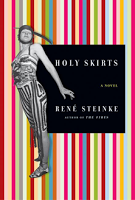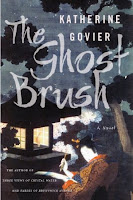
I find myself reading and enjoying more and more historical fiction these days. And it seems like there are more and more options available to readers of the genre. Over the years historical fiction has changed from mostly telling the fictionalized stories of kings and conquerors and other famous lives, to giving more and more attention to the stories of lesser known—sometimes forgotten—historical figures.
 It’s that trend that I thought of when I stumbled across René Steinke’s 2005 novel Holy Skirts. Holy Skirts is an imagining of the life of Baroness Elsa von Freytag–Loringhoven. The Baroness—a German born poet and artist who lived in NYC during the early part of the 20th Century—remains known in some circles but to a wider population is largely hidden. I include myself in that larger population, but was intrigued when I first peeked at the jacket description from the book:
It’s that trend that I thought of when I stumbled across René Steinke’s 2005 novel Holy Skirts. Holy Skirts is an imagining of the life of Baroness Elsa von Freytag–Loringhoven. The Baroness—a German born poet and artist who lived in NYC during the early part of the 20th Century—remains known in some circles but to a wider population is largely hidden. I include myself in that larger population, but was intrigued when I first peeked at the jacket description from the book:
“In 1917, no one had ever seen a woman like the Baroness Elsa von Freytag–Loringhoven. She regally stalked the streets of Greenwich Village wearing a bustle with a flashing taillight, a brassiere made from tomato cans, or a birdcage necklace; declaimed her poems to sailors in beer halls; and enthusiastically modeled in the nude for artists such as Man Ray and Marcel Duchamp, setting the city ablaze with her antics. Before today’s outsized celebrities, there was the Baroness—poet and artist, proto-punk rocker, sexual libertine, fashion avatar and troublemaker. At the center of the Dadaist circle, the Baroness transformed herself into a living, breathing work of art“
Much as the real Baroness must have done in life, the character of the Baroness strides page by page through the novel, making bold statements with her words and her fashions, and seeming a strikingly modern version of a women, even amongst the Bohemian artists of her social circles. Her story is one of passion and suffering, of a mind both creative and troubled: the sort life that lends itself to fiction, largely because it’s hard to believe that such a woman could have existed.
But it is not just because of the Baroness as character that the story works: the strength of writing that Steinke employs—her descriptive ability and her sense of human nature—allow this to shine as a novel. Surprisingly to me, Holy Skirts (the name comes from one of the Baroness’ published poems) which received some positive critical attention when it was published (including being a finalist for the 2005 National Book Award) , is not a book I’ve heard talked about much now, but its certainly worth adding to your reading list.
 Finishing the book, the first thing I wanted to investigate was the truth of the Baroness’ life. In her author’s note, Steinke reminds readers that Holy Skirts is a fictional account and details some of the liberties she took in bringing her novel to the page. So I was pleased to uncover a recent biography called Baroness Elsa: gender, Dada and everyday modernity: a cultural biography, by Irene Gammel, which looks at the her life in the cultural context of the time, including her friendships and relationships with Man Ray and Marcel Duchamp as noted above and a cast of other important 20th century figures from modernist author Djuna Barnes, to German architect August Endell and Canadian novelist Frederick Patrick Grove.
Finishing the book, the first thing I wanted to investigate was the truth of the Baroness’ life. In her author’s note, Steinke reminds readers that Holy Skirts is a fictional account and details some of the liberties she took in bringing her novel to the page. So I was pleased to uncover a recent biography called Baroness Elsa: gender, Dada and everyday modernity: a cultural biography, by Irene Gammel, which looks at the her life in the cultural context of the time, including her friendships and relationships with Man Ray and Marcel Duchamp as noted above and a cast of other important 20th century figures from modernist author Djuna Barnes, to German architect August Endell and Canadian novelist Frederick Patrick Grove.
If you’re interested in novels and nonfiction about the hidden lives of women in history, you may also want to investigate these books:

The Forest Lover by Susan Vreeland: A fictional account of the life of Canadian painter Emily Carr. Although for Canadians it might seem strange to think of Carr and a forgotten woman of history, American author Vreeland’s website notes that Carr is not well known at all beyond our borders.
The Ghost Brush by Katherine Govier: here a Canadian author looks at the life of a Japanese painter. The story of O-Ei, daughter of master painter Hokusai, her life and her role in his art.

Well Behaved Women Seldom Make History by Laurel Thatcher Ulrich. The title of the book is a quote from an article the author had penned during her grad school days, which then became a popular catch phrase. This nonfiction title looks at why the quote had appeal, while telling the stories of a number of women that history has largely forgotten.


